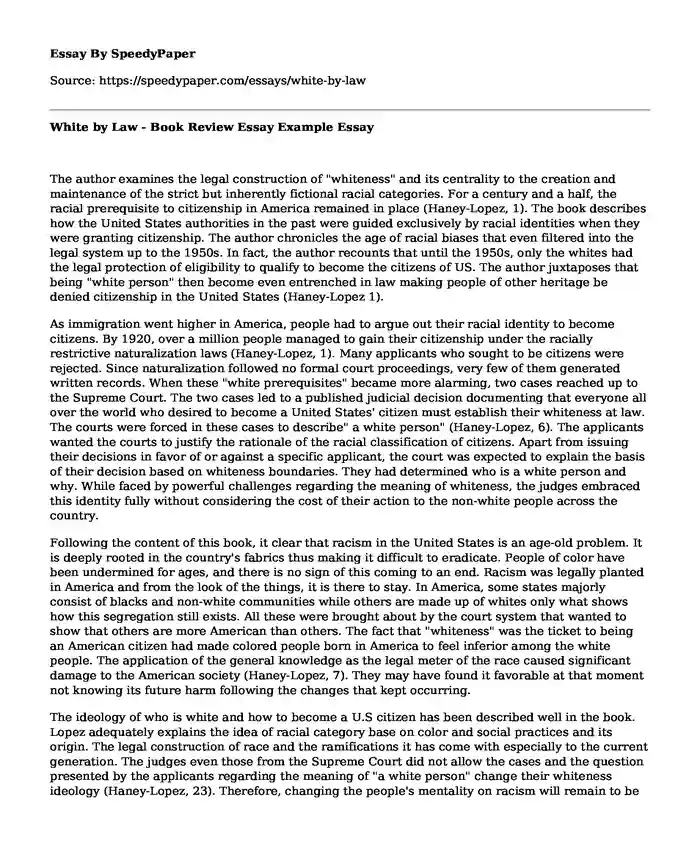
| Essay type: | Book review |
| Categories: | Race Immigration |
| Pages: | 3 |
| Wordcount: | 643 words |
The author examines the legal construction of "whiteness" and its centrality to the creation and maintenance of the strict but inherently fictional racial categories. For a century and a half, the racial prerequisite to citizenship in America remained in place (Haney-Lopez, 1). The book describes how the United States authorities in the past were guided exclusively by racial identities when they were granting citizenship. The author chronicles the age of racial biases that even filtered into the legal system up to the 1950s. In fact, the author recounts that until the 1950s, only the whites had the legal protection of eligibility to qualify to become the citizens of US. The author juxtaposes that being "white person" then become even entrenched in law making people of other heritage be denied citizenship in the United States (Haney-Lopez 1).
As immigration went higher in America, people had to argue out their racial identity to become citizens. By 1920, over a million people managed to gain their citizenship under the racially restrictive naturalization laws (Haney-Lopez, 1). Many applicants who sought to be citizens were rejected. Since naturalization followed no formal court proceedings, very few of them generated written records. When these "white prerequisites" became more alarming, two cases reached up to the Supreme Court. The two cases led to a published judicial decision documenting that everyone all over the world who desired to become a United States' citizen must establish their whiteness at law. The courts were forced in these cases to describe" a white person" (Haney-Lopez, 6). The applicants wanted the courts to justify the rationale of the racial classification of citizens. Apart from issuing their decisions in favor of or against a specific applicant, the court was expected to explain the basis of their decision based on whiteness boundaries. They had determined who is a white person and why. While faced by powerful challenges regarding the meaning of whiteness, the judges embraced this identity fully without considering the cost of their action to the non-white people across the country.
Following the content of this book, it clear that racism in the United States is an age-old problem. It is deeply rooted in the country's fabrics thus making it difficult to eradicate. People of color have been undermined for ages, and there is no sign of this coming to an end. Racism was legally planted in America and from the look of the things, it is there to stay. In America, some states majorly consist of blacks and non-white communities while others are made up of whites only what shows how this segregation still exists. All these were brought about by the court system that wanted to show that others are more American than others. The fact that "whiteness" was the ticket to being an American citizen had made colored people born in America to feel inferior among the white people. The application of the general knowledge as the legal meter of the race caused significant damage to the American society (Haney-Lopez, 7). They may have found it favorable at that moment not knowing its future harm following the changes that kept occurring.
The ideology of who is white and how to become a U.S citizen has been described well in the book. Lopez adequately explains the idea of racial category base on color and social practices and its origin. The legal construction of race and the ramifications it has come with especially to the current generation. The judges even those from the Supreme Court did not allow the cases and the question presented by the applicants regarding the meaning of "a white person" change their whiteness ideology (Haney-Lopez, 23). Therefore, changing the people's mentality on racism will remain to be a difficult thing since even the learned group cannot change their mindset.
Work Cited
Haney-Lopez, Ian. White by Law 10th Anniversary Edition: The Legal Construction of Race. NYU P, 2006.
Cite this page
White by Law - Book Review Essay Example. (2022, Sep 19). Retrieved from https://speedypaper.com/essays/white-by-law
Request Removal
If you are the original author of this essay and no longer wish to have it published on the SpeedyPaper website, please click below to request its removal:
- Free Essay on Business Philosophy in the Case of Facebook
- Free Essay: Review of Regulations and Standards for Surgical Site Infection
- History Essay Example: Failures of the International Actors in Rwanda Genocide
- Free Essay That Includes Visual Basic Project Documentation
- Short Independent Research ProjectIntroduction
- Essay Example - The Responsibility for the Adverse Event to the Patient
- Essay Sample on The Gender Similarities Hypothesis
Popular categories




